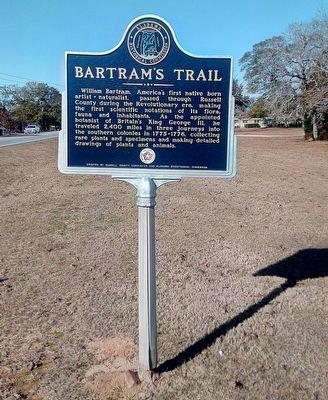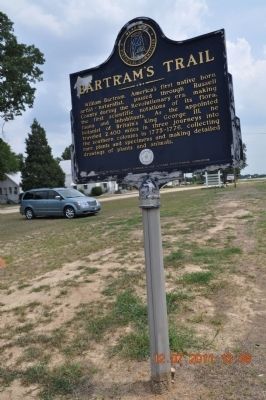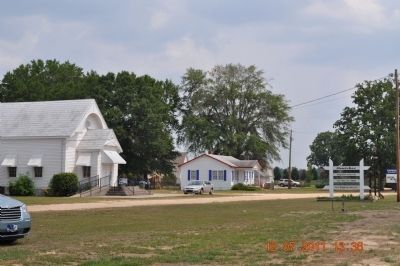Fort Mitchell in Russell County, Alabama — The American South (East South Central)
Bartram's Trail
Erected by Erected by Russell County Commission and Alabama Bicentennial Commission.
Topics and series. This historical marker is listed in these topic lists: Arts, Letters, Music • Colonial Era • Environment • Horticulture & Forestry. In addition, it is included in the The Spirit of ’76, America’s Bicentennial Celebration, and the William Bartram Trails series lists.
Location. 32° 16.668′ N, 85° 0.196′ W. Marker is in Fort Mitchell, Alabama, in Russell County. Marker is on Alabama Route 165 north of Creek Trail, on the right when traveling north. Marker is located next to Oswichee Baptist Church. Touch for map. Marker is at or near this postal address: 1049 AL-165, Fort Mitchell AL 36856, United States of America. Touch for directions.
Other nearby markers. At least 8 other markers are within 5 miles of this marker, measured as the crow flies. Fryar Field (approx. 3.1 miles away); Macedonia Missionary Baptist Church / Macedonia School (approx. 3.2 miles away); Spanish Fort, 1689-1691 (approx. 4 miles away); Pokkecheta, or the Ball Play (approx. 4.7 miles away); J.W. and Ethel I. Woodruff Foundation Interpretive Trail (approx. 4.7 miles away); Indian Ball Ground (approx. 4.7 miles away); Archaeology And Our Understanding of the Creek People (approx. 4.7 miles away); Fort Mitchell and Creek Removal (approx. 4.7 miles away). Touch for a list and map of all markers in Fort Mitchell.
Also see . . . Google Earth. Driving directions to Oswichee Baptist Church (Submitted on October 17, 2011, by Sandra Hughes Tidwell of Killen, Alabama, USA.)
Additional commentary.
1. Regarding the Royal Appointment
William Bartram was not the king's botanist as this marker claims. John Bartram, William's father, was appointed the King's Botanist for North America in 1765 and held that post until his death in 1777. John Bartram routinely corresponded with a community of persons interested in botany. One such individual was John Fothergill, an English physician and owner of a large botanical garden. Fothergill supported William's expedition through the southern colonies from 1773 until 1777 with payments of £50 per year plus an additional allowance for expenses. During his journey William made shipments to Fothergill that included dried plant specimens, zoological and botanical drawings, and a report on his travels. Note To Editor only visible by Contributor and editor
— Submitted February 22, 2012, by Harry Gatzke of Huntsville, Alabama.
Credits. This page was last revised on January 6, 2021. It was originally submitted on October 17, 2011, by Sandra Hughes Tidwell of Killen, Alabama, USA. This page has been viewed 1,520 times since then and 50 times this year. Last updated on January 6, 2021, by James L.Whitman of Eufaula, Alabama. Photos: 1. submitted on January 6, 2021, by James L.Whitman of Eufaula, Alabama. 2, 3. submitted on October 17, 2011, by Sandra Hughes Tidwell of Killen, Alabama, USA. • Mark Hilton was the editor who published this page.


